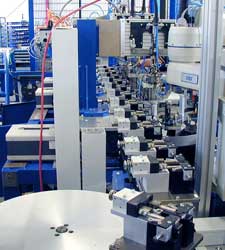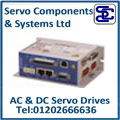
Posted to News on 14th Jul 2008, 17:16
Transfer system offers benefits over pallets and rotary indexing
Rotary indexing table or pallet transfer system? Both options have their own advantages and in the past it has always been necessary to weigh these advantages against each other. However, a new system from Weiss is claimed to eliminate this dilemma and provide the best of both worlds.

Weiss says its alternative offering is faster, more precise and more reliable. These three promises are something that every special-purpose machine manufacturer likes to hear from the suppliers of transfer or indexing systems so that the benefits can be passed on to the customer. Every tenth of a second cycle time, every micrometre of positioning accuracy and every percentage point of machine availability is particularly important in automated assembly and test machines for high-volume production. Unfortunately, experience has shown that in some cases other things suffer in return. Quick cycle times may bring inaccuracies, precise positioning requires time, and sophisticated bespoke designs offering both can be temperamental .
Weiss claims to be breaking new ground and has transformed the principle of the rotary indexing table - with its speed, precision and reliability - into a linear assembly system. Customers' curiosity is heightened when, on closer inspection, they discover a component familiar to them - the cylindrical cam or scroll. The Weiss LS linear transfer system is, in principle, nothing other than a linear, modular, user-defined, extendable 'rotary' indexing table.
How it works
Two workpiece carriers are linked together to form a pair, which run using precision guide rollers on a central guide rail. The carrier pair, with its lateral roller bearings, is picked up by a cylindrical cam at the entrance to the carrier locking station. Here the linear system effectively mimics a rotary indexing table with all its associated advantages: fast indexing time, gentle but rapid acceleration and deceleration, and, above all, highly accurate positioning without the need for additional operations such as lift and locate stations.
Based on a 70mm indexing pitch, this principle enables up to 60 smooth cycles per minute. Although these features may well lie within the capabilities of a rotary indexing table, anyone who compares the fast 0.4s changeover time for the workpiece carrier with systems of similar linear geometry will recognise the advantages that Weiss can provide by 'straightening out the curve.' Another benefit of the cylindrical cam principal used on the LS system is the fact that there are no problems with tolerance build-up, which is a common issue on mechanically linked linear indexing systems.
A simple conveyor belt takes over the transportation of the carrier pairs between the individual locking stations. The distribution of tasks between cylindrical cam and conveyor belt facilitates different speeds within the line. In this way, for example, speed-regulated transport of the carrier pairs makes buffer conveyors largely unnecessary so that fewer workpiece carriers are required and installation of the system can be compact and more cost-effective.
What may sound difficult and complex when described in words is, in reality, a homogeneous, compact and easily accessible system - which was convincing enough for the Managing Director of Dorner Engineering.
This special-purpose machine manufacturer focuses on assembly and production engineering, with many customers across a wide range of industries including the automotive and component supply industry, electronics, measurement technology, packaging and food. Dorner has been working with Weiss for over ten years. A spokesman from Dorner says: "As a rule, clients often dictate which transfer system we should install in their plants. We quickly recognised the advantages of the Weiss linear transfer system, however, and were soon able to convince our customers that we should replace the traditional twin-belt pallet system with a linear transfer system from Weiss."
The system in question was designed and built for the assembly of housings for CD and DVD navigation systems. The individual operations taking place within the system include feeding of component parts, welding operations using a laser, and the subsequent checking of dimensions and welding seams using an image processing system.
Throughout doubled
A traditional system, based upon a conveyor belt transfer line, would achieve a minimum cycle time of 5s. In comparison, the cylindrical cams within the Weiss linear transfer system index the workpiece carriers in 2s or less, depending upon the process. The ability to offer effectively double the output of high-volume goods has always been a very convincing argument. The spokesman adds: "What is more, where this system is concerned, we appreciate the positioning accuracy inherited from the concepts used to index rotary tables."
The new system exploits the technology of the rotary indexing table but frees it at the same time from the disadvantages of space restrictions. The modular construction with locating station, conveyor belt, corner units and stop units makes it possible, should the need arise, to extend or modify the system.
It is no wonder, therefore, that this first project was soon followed by another. The new task - assembly, testing and packaging of fuel connectors - in the past, would probably have been solved in the classic manner using a rotary indexing table. The spokesman states: "However, the number of product variations in this case was very high, and the system is required to be retooled two to three times a day. Apart from its flexibility, we benefited from excellent accessibility to the Weiss LS linear transfer system." In contrast to a rotary indexing table, the individual processes can therefore access the workpiece from above, from below and from both sides equally well.
Other linear transfer systems offer advantages but seldom in combination with an additional feature of the Weiss system. In line with the cam pitch, the locating station can index the workpiece carriers at either 70, 140, 280 or 560mm pitches. The slowest process no longer determines the cycle time. It therefore becomes possible in the case of longer processing cycles - the case in question being a differential pressure test of the assembled connectors - to incorporate a double or quadruple cycle. By doubling or quadrupling the appropriate operational stations, processes can be carried out in-line within the system. Conventional linear transfer systems, on the other hand, would require shuttling the pallets to an parallel conveyor loop offline. This feature reduces the complexity of the system for time-consuming operations such as bonding, screwing, testing operations, thereby increasing reliability and ultimately reduces costs.
The modular construction of the Weiss LS linear transfer system, with its accurate interfaces between the individual elements, allows different build teams to construct different system elements simultaneously. Not only is this system fast in production, but the build concept also reduces machine delivery times.
The benefits that this client realised on the connector assembly project have been confirmed by follow-up orders. This means that the principle of 'straightening the curve' is rapidly gaining recognition. Weiss manufactured over fifty systems in the last year alone and because 'faster, more precise and more reliable' is a timeless motto in the industry, Weiss believes its linear transfer system will carve out a firm position for itself amongst all of the other methods used to transport a workpiece from A to B.















